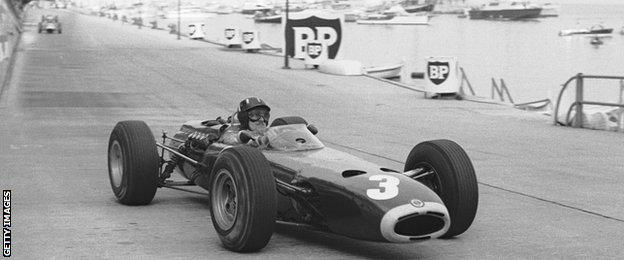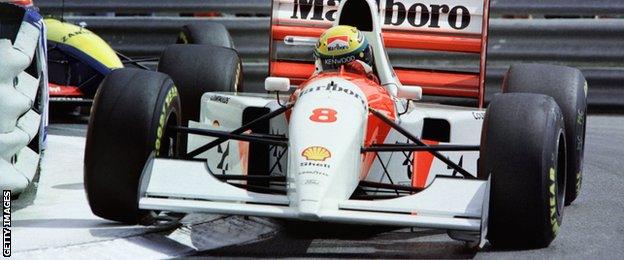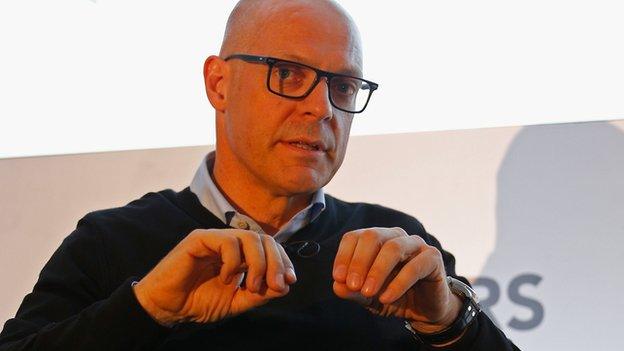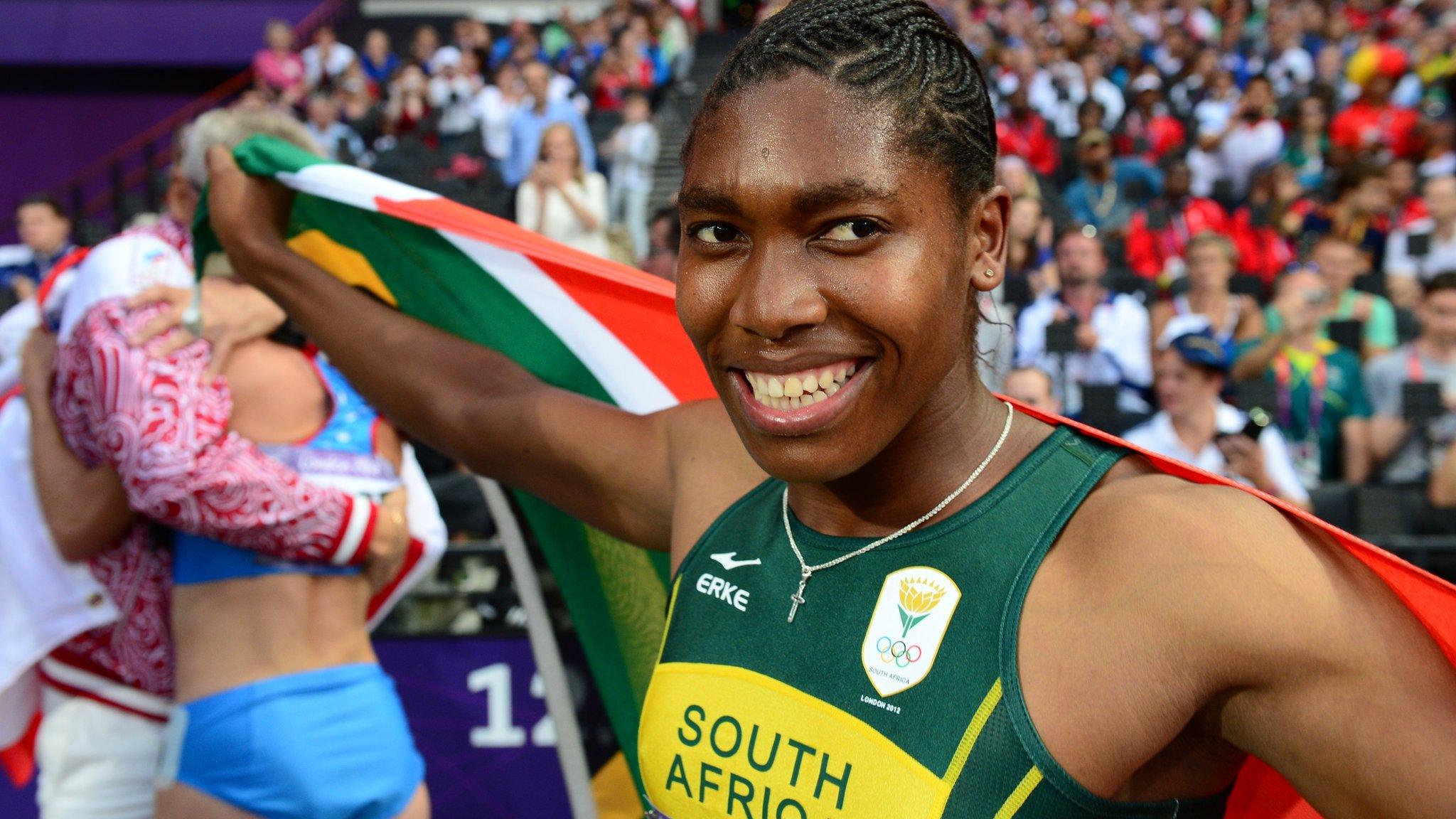Monaco Grand Prix is like nowhere else on Earth
- Published
Split-screen: Four eras of Monaco
Monaco Grand Prix |
|---|
Venue: Circuit de Monaco-Monte Carlo Dates: 21-24 May |
Live text and radio commentary via the BBC Sport website and app, plus qualifying and race highlights on BBC One. Full coverage details here. |
The Monaco Grand Prix stands alone as an iconic event that has come in many ways to define the sport of which it is a part.
It is so completely unlike any other sporting event that it is hard to grasp.
Monaco itself is tiny - it is a country in its own right, external but, with an area of 0.76 square miles, it is smaller than New York's Central Park.
With 36,000 residents, it is one of the most densely populated spaces on the planet.
It is effectively built on a cliff close to the French-Italian border. And the racing circuit is a narrow ribbon of asphalt that winds around the town.
Monaco, like Le Mans and Indianapolis, transcends the sport. It doesn't matter whether you're interested in motorsport or not, Monaco is a name that matters.
History and secrets
Monaco was first used for grand prix racing in 1929, and the track has been largely unchanged since.

The Monaco circuit has remained largely unchanged since the days of Graham Hill
I was at an event at the RAC Club in London last week, and a magazine there had on the cover a picture of Graham Hill going through Casino Square in the 1960s.
The amazing thing is that, as far as the circuit is concerned, hardly anything that can be seen on that shot has changed since.
It is the same for a picture I have of Hill's contemporary Jim Clark in my office at home. He is coming around what was then called Station hairpin in his Lotus.
Lewis Hamilton and the rest will drive around the same corner this weekend. The only difference is there is a hotel there now instead of a railway station.
And so it goes on around the track, external, with very few exceptions.
These days, the tunnel is a little longer than it used to be. The walls at the Swimming Pool section have been moved back. And the left-hand kink on the approach to Rascasse has been eased to provide some run-off by reclaiming some land.
The track is a little less bumpy than it was, particularly around the harbour on the approach to Tabac and the Swimming Pool, and the crown in the road has been reduced, too.
But those are all very subtle changes and the circuit remains what it has always been - a unique challenge for a driver, with so many little secrets and nuances that are critical to a good lap time.
A good example of that is the run up to and through Casino Square.
Climbing the hill out of the first corner, Sainte Devote, the driver is already thinking about Massenet, the very tricky, long left-hander that leads into Casino Square.
As you turn into that corner, a tiny bit of kerb juts out below the barrier. That is your apex point.
But you cannot just follow the barrier around because the kerb does not have a consistent radius.
After that, you flick right through Casino Square and as you head down the hill towards Mirabeau, there is a little bump by the Tip-Top bar on what would be the racing line that they have to avoid - which is why you see the cars jinking out to the right on what is a very short straight between the two corners.
Why do they not level out that bump as they would on all other tracks? It is because there is a road to the left-hand side, the entrance to a hotel, that you would not get up otherwise.
Even the Tip-Top itself is part of F1 history. It has been around for decades - Graham Hill used to celebrate his victories there back in the 1960s - and if anyone is going to Monaco for the race it is a great little place to spend some time. It is open all night, the food is nice, there is a great atmosphere - although, like anywhere in Monaco, it is not exactly cheap.
As it happens, that bump is not such a problem as you would expect, because drivers naturally want to brake more in the middle of the road for Mirabeau than on the traditional racing line because the big camber there slingshots you into the corner.
Man and machine in harmony

Ayrton Senna mastered the claustrophobic conditions of Monaco, winning there six times
To go well at Monaco, a driver needs to feel completely on top of his car. He needs total confidence in it.
Some drivers actually raise their seating position slightly for this race. The small compromises in aerodynamics and centre of gravity height this creates are more than compensated by the better visibility, which allows you to place the car that little bit better.
That is important because a quick lap around Monaco requires a driver to be millimetres from the barriers, external all the way around, sometimes even shaving them.
At Tabac, for example, the entry is blind, the apex point is the actual barrier and you are aiming for a gap in the barriers on the exit that you cannot see.
It is one of the most horrible, and yet most enjoyable, tracks of the season and the finesse required to do that will never change as long as Monaco remains a race track. That is why it is a circuit where all the masters have won.
The driver needs an innate sense of where the limits are and it is no coincidence at all that the only current drivers to have won there are Hamilton, Fernando Alonso, Jenson Button, Kimi Raikkonen, Nico Rosberg and Sebastian Vettel.
Irreplaceable, unrepeatable

For once, the cars take a back seat to the overall spectacle of the circuit itself as it snakes along the harbourside
Monaco's uniqueness will always remain. There will never be another place like it, because if a new track was proposed that had the constraints and compromises of Monaco, no-one would accept it - no driver, no team, no official.
It is not just the drivers who are pushed to the edge, either. It is a tough place for the teams to work, because space is so restricted.
But being there is like nowhere else on Earth.
Sit in the pit lane and look left and you have the hill up to the Hotel de Paris and Casino, which has been refurbished for this season. Look right and you have the Prince's palace on the hill.
Straight ahead is the harbour. The Mediterranean shimmers and it is filled with the biggest, most expensive yachts you can imagine.
It is like a scene from a movie, and that romance and mystique means it will always have its place on the calendar.
A home grand prix for many

Lewis Hamilton is just one of many F1 drivers to have made Monte Carlo their home
For many of the drivers, Monaco is a home grand prix - Hamilton, Rosberg, Button, Daniel Ricciardo and Felipe Massa are just some of the drivers who live there year-round.
That brings its own comforts - you can sleep in your own bed at night, rather than a hotel, for example.
Living there means that you also see the track being built. It takes roughly two and a half months to build the track from start to finish and six weeks to take it back down again.
The roads are already there, of course, but the barriers and grandstands and so on all need putting up and taking down again.
But there is another side to it - it is Monaco and everyone wants to come. For first-year drivers in F1, all and sundry tends to arrive on their doorstep.
Just as every driver wants to win Monaco, every fan wants to go there. And quite right, too. There is, quite simply, nothing else like it.
Allan McNish is a two-time Le Mans winner and former world endurance champion, and raced in F1 for Toyota. He was talking to Andrew Benson
- Published20 May 2015

- Published20 May 2015

- Published19 May 2015

- Published18 December 2015

- Published2 November 2018

- Published26 February 2019
